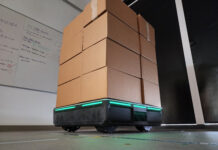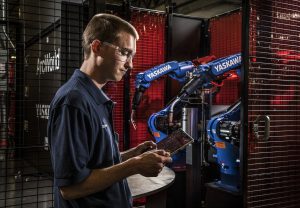 The economy is rapidly growing and prompting American companies to give a second look at the viable path to profitability robotic automation solutions can offer. Simultaneously, the current trade climate is witnessing increased tariffs from all countries, creating basic incentive to produce more products in the country where they will be sold. Thus, more affordable and sophisticated robotic technology is driving an uptick in automation usage, allowing companies to scale and expand capabilities to more customers in diverse markets than ever at lower marginal costs.
The economy is rapidly growing and prompting American companies to give a second look at the viable path to profitability robotic automation solutions can offer. Simultaneously, the current trade climate is witnessing increased tariffs from all countries, creating basic incentive to produce more products in the country where they will be sold. Thus, more affordable and sophisticated robotic technology is driving an uptick in automation usage, allowing companies to scale and expand capabilities to more customers in diverse markets than ever at lower marginal costs.
The possibility of achieving corporate growth and profit gains during this exciting time has a reshoring revolution knocking at America’s doorstep. A strong economic manufacturing base is lending itself to an increase in employment opportunities, and the American job market is no exception, reflecting such a trend. However, with the unemployment rate hovering around 4%, finding workers with the needed abilities or mere willingness to perform specialized, and sometimes challenging, tasks is difficult to say the least.
According to the International Federation of Robotics (IFR), by 2020 there will be 1.71 million new industrial robots introduced into production factories around the world. And by that time, there will be 162 million new consumers per the UN World Population Prospects. This wide use of robotic automation, in conjunction with lean manufacturing processes, is ushering more manufacturers toward organizational success, but reaching this level of achievement does not come without certain challenges.
Minding the Skills Gap
Drastic changes in the employment landscape over the last decade have generated valid concerns about the lack of skilled labor to fill the escalating job gap. This skills gap has fueled science, technology, engineering and math (STEM) education initiatives. Despite these successful on-going efforts, the pool of qualified talent is still shrinking when it is needed most – as a recent Deloitte study reports the manufacturing skills gap, at the present pace, will continue to grow to a shortage of two million workers over the next decade.
To help compensate for this labor deficit, company decision makers across various industrial sectors are identifying areas for automation, where robots with well-defined parameters can complete basic tasks. Robots have been deployed in factories across the world to conquer the three D’s (dull, dirty or dangerous), to complete duties human employees are physically unable to fulfill, or to accomplish dangerous or high-turnover tasks that would otherwise remain undone. Not only does this satisfy the lack of highly-trained workers, but also, the use of robotic automation is helping businesses increase product quality, reduce cycle-time, enable on-time delivery, lower labor costs, and improve business services, propelling competitive advantage and enhancing monetary gains.
While advancements to robotic technology have greatly increased application capabilities in the last decade, robots still have limited abilities and require qualified personnel to build, program, operate and maintain them. Thus, employers need to be mindful of hiring practices and employee retention throughout the implementation process, offering unique incentives and educational opportunities to maintain worker satisfaction and productivity.
The Cause for Redeployment
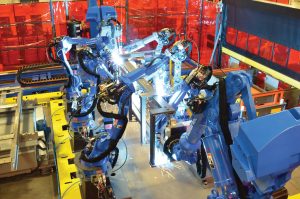
As more and more workers are wearing multiple hats on a daily basis to meet organizational goals and customer demands, employers are taking a step back to view the bigger picture, enacting innovative methods and investing valuable resources to bolster employee satisfaction while creating new business opportunities. As a company’s profit rises, so will its wages by classic economic theory. Companies are realizing that simply scaling organizational problems through automation solutions is only part of the equation.
Automation of human jobs does have the perceived potential to displace workers, but savvy decision makers have the ability to ward off issues before they start. Companies seeking robotic automation solutions to improve quality and increase productivity will need to take prudent steps to avoid unnecessary unrest for a seamless integration process.
Facilitate Open Communication
Employers should have open communication with workers before and during the installation process. Gaining valuable employee feedback through honest discussion not only makes the employee feel like a valued team member, but also, effective communication can go a long way to keeping problems to a minimum.
Boost Employee Morale
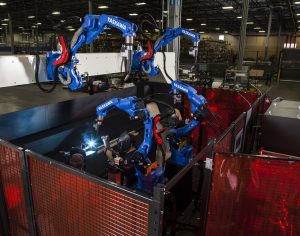
Company leaders need to be mindful of employee morale. When new technologies are introduced into the workplace, it can be overwhelming for some employees to learn unfamiliar concepts and apply them. Or, in some cases, workers may be assigned new tasks to fill other areas of need. If change happens haphazardly, active disengagement can result, which may lower employee morale and result in employee turnover.
Engage Human Resources
More specifically, human resource departments need to be included in the event that workers are reassigned from the dull, dirty, or dangerous tasks that robots can perform. With the growing skills gap, it is always more advantageous and cost-effective for companies to retain and retrain employees, instead of letting them go. New specialized opportunities in maintenance, technical support, quality assurance, and other areas will grow as automation is introduced. Proper retraining and empowering employees will continue to increase productivity as well, providing a safer, more engaging work environment for the employees.
Decision makers need to have a strategic plan for robotic automation implementation. Intentional communication, employee inclusion and collaboration with human resources to create strategies for training, retaining and incentivizing workers will prime companies for success.
Creative Ways to Redeploy
Workers displaced by automation and redeployed to other responsibilities more in-line with their specific skill sets, will most likely be more content and productive, making the company more competitive.
For example, manufacturers may find that the more innovative a method, the more successful it will be. Several redeployment examples early automation adapters have used are: 1) converting current welders into quality inspectors, 2) moving extrovert employees into sales or technical support, or 3) creating robotic workcell “champions” – employees fully dedicated to robot programming and utilization. No matter the talent strategies used to keep a step ahead of competitors, businesses will need to think of unique ways to provide value to their employees and operation.
The New Reality
I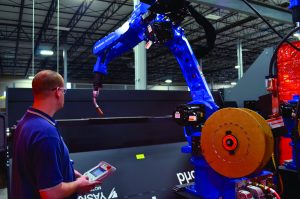 magine this: you are a welder for a medium-sized, family-owned company in the United States, and your employer’s recent purchase of a robotic welding workcell has you wondering if your job will be intact after the integration is complete. Much to your surprise, not only does your employer keep you on the payroll, but also you are promoted to a key position for a newly introduced “custom order fulfillment division”, where your in-depth knowledge of welding is put to better use to achieve revised company growth initiatives. Moreover, to ensure the best possible return on investment (ROI) for the robotic workcell, company leaders invest in employee education, sending you and over a dozen of your co-workers to a world-class robotics training facility.
magine this: you are a welder for a medium-sized, family-owned company in the United States, and your employer’s recent purchase of a robotic welding workcell has you wondering if your job will be intact after the integration is complete. Much to your surprise, not only does your employer keep you on the payroll, but also you are promoted to a key position for a newly introduced “custom order fulfillment division”, where your in-depth knowledge of welding is put to better use to achieve revised company growth initiatives. Moreover, to ensure the best possible return on investment (ROI) for the robotic workcell, company leaders invest in employee education, sending you and over a dozen of your co-workers to a world-class robotics training facility.
This real-life scenario is becoming the norm for many workers. As more company leaders understand the need for a wide array of unique talents to stay competitive in today’s ever-changing industrial marketplace, the more current employees will be redeployed to other job responsibilities, like personnel management, quality control and technical support. In turn, re-focusing employee skills on less redundant and more specialized tasks increases worker satisfaction, reducing turnover in the process.
In a sense, the use of automation today is increasing the importance for human intelligence, judgement and creativity. Proactive companies that embrace technology, especially robotic automation, while preparing for the challenging pace of change in creative ways, like redeployment, will have the ability to adjust to market demands and thrive.
The Future of Redeployment
Increased product individualization, shorter product life cycles and various market demands continue to cause production inefficiencies among America’s innovative landscape. To effectively manage this influx in manufacturing complexity, more companies are turning toward human-collaborative robot (cobot) utilization.
The use of cobots is spawning a manufacturing movement, where centralized production facilities are being overtaken with the promising Distributed Manufacturing System (DMS) approach – where a network of regionally dispersed manufacturing facilities, intertwined with workstations, are managed by empowered employees and coordinated by smart technologies.
As the trend for industrial and collaborative robots in manufacturing facilities rises, the need for redeployment strategies will grow, and while critics may doubt the advantages that robotic automation solutions can offer, robots today increasingly meet or exceed requirements for diverse industries in every regard. As long as a modern free market exists anywhere in the world, a 15-hour work week will never be achieved – as economist John Keynes once predicted would be the outcome of automation. Therefore, embracing technological investment is the sole survival strategy for a productive manufacturer today.
Overall, the use of robotics can improve product quality and operational productivity, but before implementation, businesses should follow realistic budgets to meet well-defined organizational goals. Likewise, upon the commissioning of a new system, ramp-up time is critical to meeting a target payback period. These considerations, along with the implementation of redeployment strategies, can make a monumental difference for the future of manufacturing in America and around the world.

































